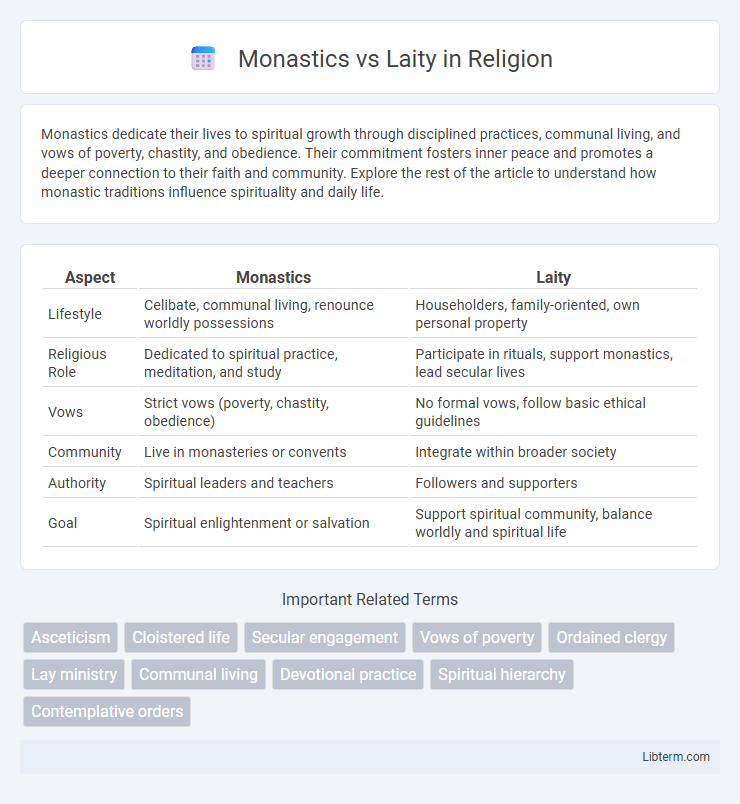Monastics dedicate their lives to spiritual growth through disciplined practices, communal living, and vows of poverty, chastity, and obedience. Their commitment fosters inner peace and promotes a deeper connection to their faith and community. Explore the rest of the article to understand how monastic traditions influence spirituality and daily life.
Table of Comparison
| Aspect | Monastics | Laity |
|---|---|---|
| Lifestyle | Celibate, communal living, renounce worldly possessions | Householders, family-oriented, own personal property |
| Religious Role | Dedicated to spiritual practice, meditation, and study | Participate in rituals, support monastics, lead secular lives |
| Vows | Strict vows (poverty, chastity, obedience) | No formal vows, follow basic ethical guidelines |
| Community | Live in monasteries or convents | Integrate within broader society |
| Authority | Spiritual leaders and teachers | Followers and supporters |
| Goal | Spiritual enlightenment or salvation | Support spiritual community, balance worldly and spiritual life |
Understanding Monastics and Laity: Definitions
Monastics are individuals who dedicate their lives to religious asceticism, often residing in monasteries and adhering to strict spiritual disciplines. Laity refers to non-ordained members of a religious community who engage with faith practices while living in secular society. Understanding these definitions highlights the distinct roles and commitments within religious traditions, shaping communal worship and individual spirituality.
Historical Roots of the Monastic-Laity Divide
The historical roots of the monastic-laity divide trace back to early Christian communities where asceticism and withdrawal from worldly life distinguished monks from lay believers. Monasticism emerged in the 3rd and 4th centuries with figures like St. Anthony and St. Benedict, emphasizing spiritual discipline, communal living, and separation from secular affairs. This division established distinct roles in religious practice, with monastics focusing on contemplation and prayer while laity engaged in worldly duties and church participation.
Daily Life: Monastic Routine vs Lay Activities
Monastic daily life centers on structured routines of prayer, meditation, and communal rituals, emphasizing spiritual discipline and renunciation of worldly distractions. Lay activities typically involve engagement in family responsibilities, work, and social interactions, balancing material pursuits with occasional religious observances. The contrast highlights monastics' immersion in contemplative practices versus laity's integration of spirituality within everyday secular duties.
Spiritual Goals and Practices: A Comparative Overview
Monastics dedicate their lives to spiritual goals through rigorous practices such as meditation, celibacy, and communal living, aiming for enlightenment or union with the divine. Laity engage in spiritual practices within everyday contexts, including prayer, ritual observance, and ethical living, balancing worldly responsibilities with faith. The contrast highlights monastics' intensive, structured devotion versus laity's integration of spirituality into daily life.
Roles in Religious Communities
Monastics dedicate their lives to spiritual discipline, prayer, and communal living, often adhering to strict vows such as poverty, chastity, and obedience. Laity participate in religious communities primarily through worship, support activities, and moral guidance while maintaining secular professions. The distinct roles of monastics and laity create a complementary structure that sustains religious traditions and fosters spiritual growth within the community.
Paths to Enlightenment: Contrasting Approaches
Monastics pursue enlightenment through rigorous meditation, strict discipline, and renunciation of worldly desires, embodying the path of intensive spiritual practice within monastic communities. Laity engage in enlightenment by integrating ethical conduct, devotional practices, and mindful living into daily life while fulfilling social and familial responsibilities. Both paths emphasize adherence to core teachings such as the Four Noble Truths and the Eightfold Path, yet differ in lifestyle commitment and depth of ascetic practice.
Leadership, Authority, and Hierarchy
Monastic communities exhibit a strict hierarchical structure where leadership is typically vested in abbots or abbesses who possess spiritual authority and administrative control, guiding the community's religious practices and daily discipline. Laity leadership often functions within congregational or parish frameworks, emphasizing collaborative governance with clergy who provide spiritual guidance but less centralized authority compared to monastic settings. The distinction between monastic and laity hierarchies reflects differing models of authority: monasticism prioritizes ascetic leadership and obedience within a defined chain of command, while laity governance integrates broader communal participation and pastoral oversight.
Social Interactions and Community Impact
Monastics often engage in structured, contemplative social interactions within tightly-knit religious communities, fostering spiritual discipline and collective rituals that strengthen communal identity. Laity participate more broadly in societal networks, blending religious values with everyday social roles, which facilitates community outreach and cultural integration. The interplay between monastic dedication and laity involvement enhances social cohesion and promotes diverse support systems within religious and secular contexts.
Challenges Faced by Monastics vs Lay Followers
Monastics face challenges such as strict adherence to celibacy, communal living regulations, and intense spiritual discipline that demand renunciation of personal possessions and social ties. Lay followers encounter difficulties balancing worldly responsibilities, family obligations, and spiritual practices, often lacking the supportive structure available to monastics. Both groups struggle with maintaining commitment to their faith amidst modern societal pressures and distractions.
Evolving Relationships in Modern Society
Monastics and laity exhibit evolving relationships shaped by increasing urbanization and digital communication, which blur traditional boundaries and foster new forms of interaction and mutual support. Modern society sees monastics engaging more with laity through social media, educational programs, and community service, enhancing accessibility to spiritual teachings and practices. This dynamic promotes inclusive spiritual growth while respecting the distinct roles within religious traditions.
Monastics Infographic

 libterm.com
libterm.com